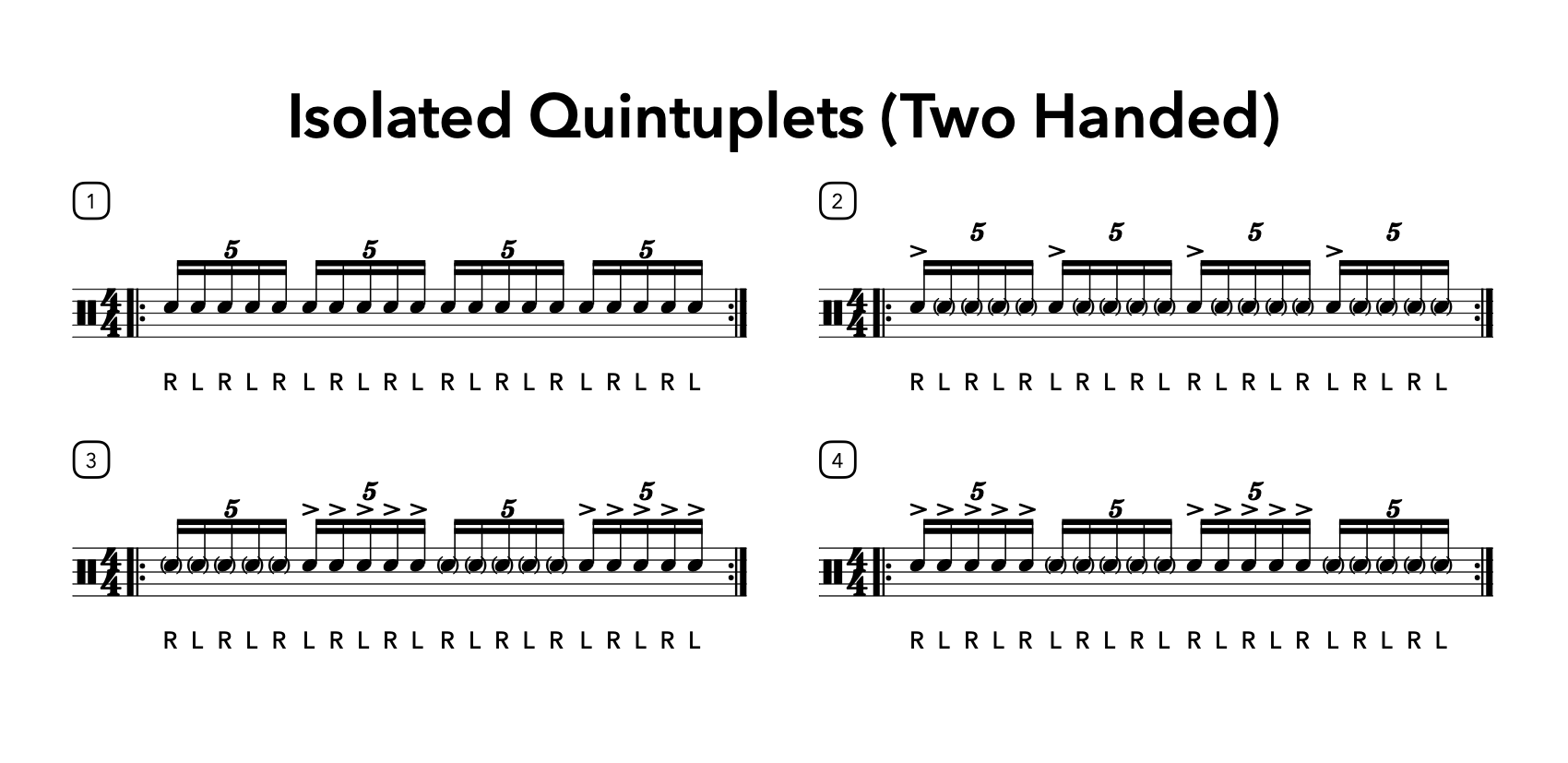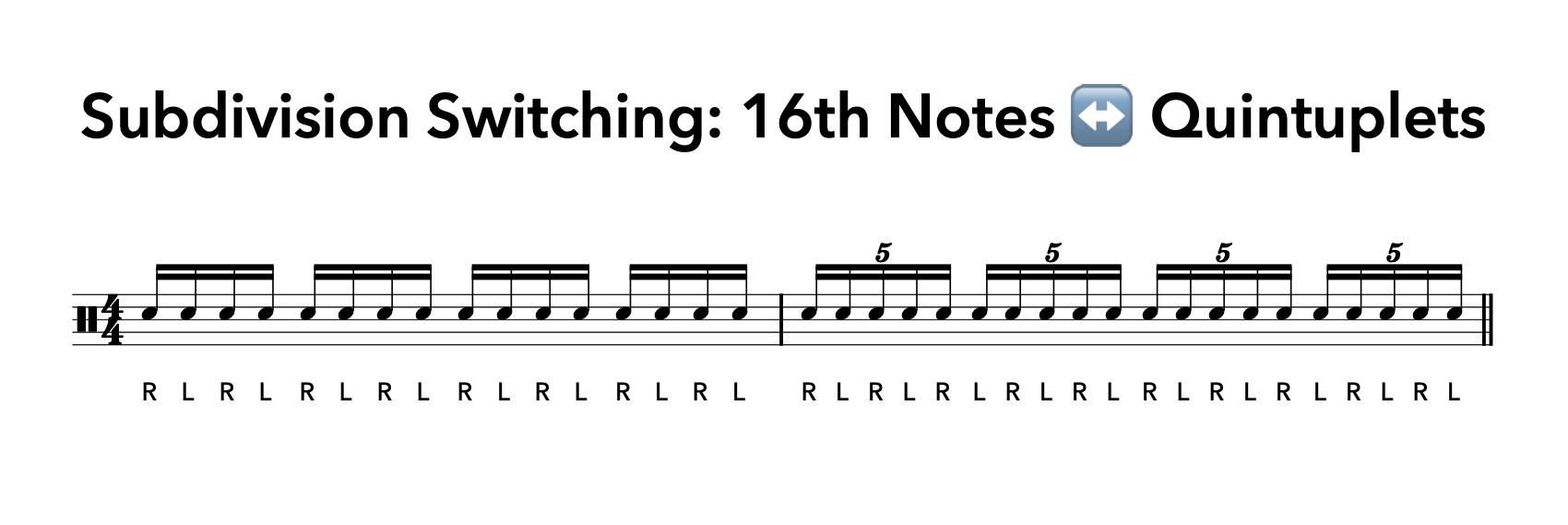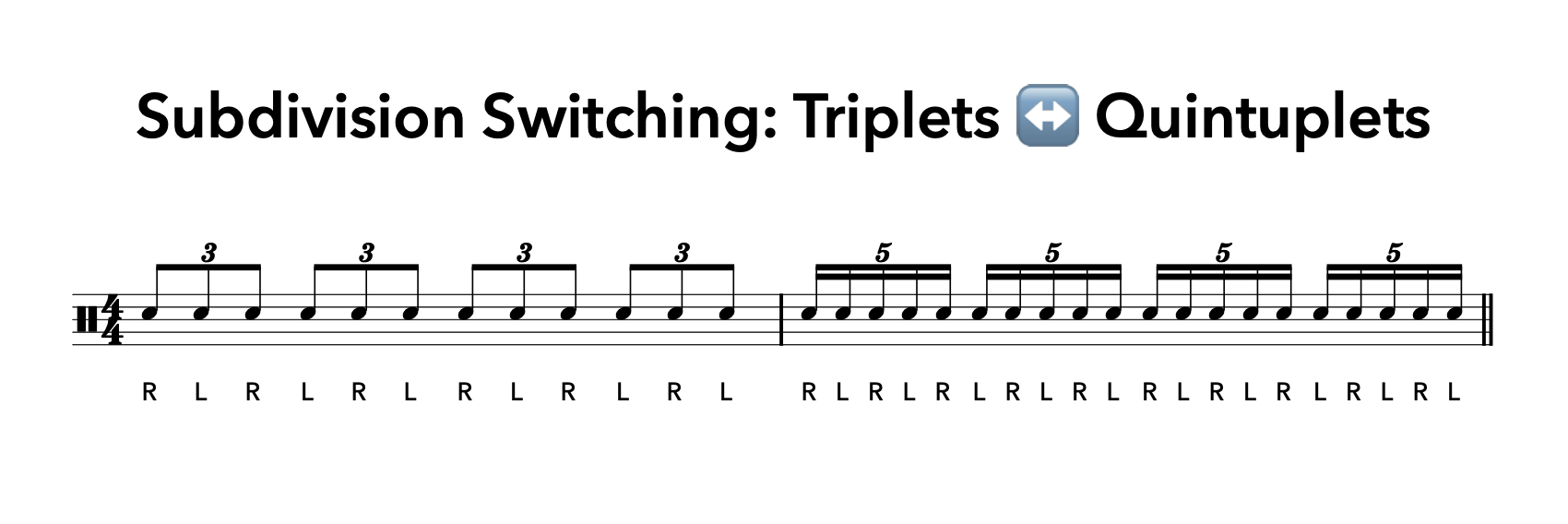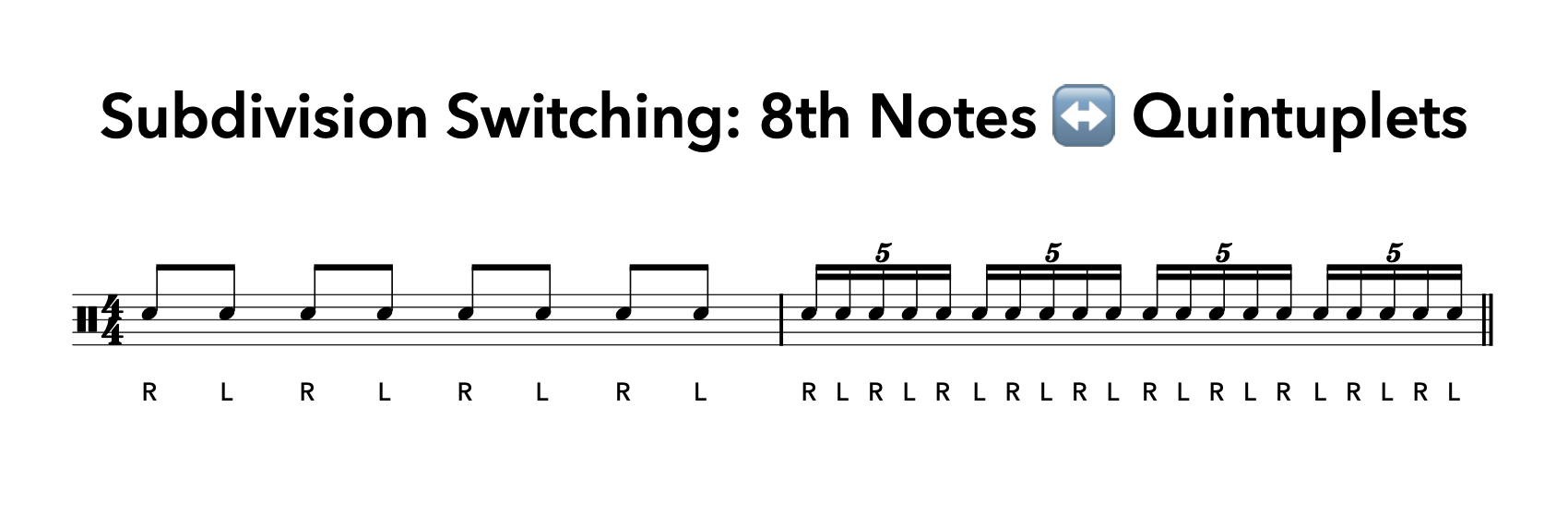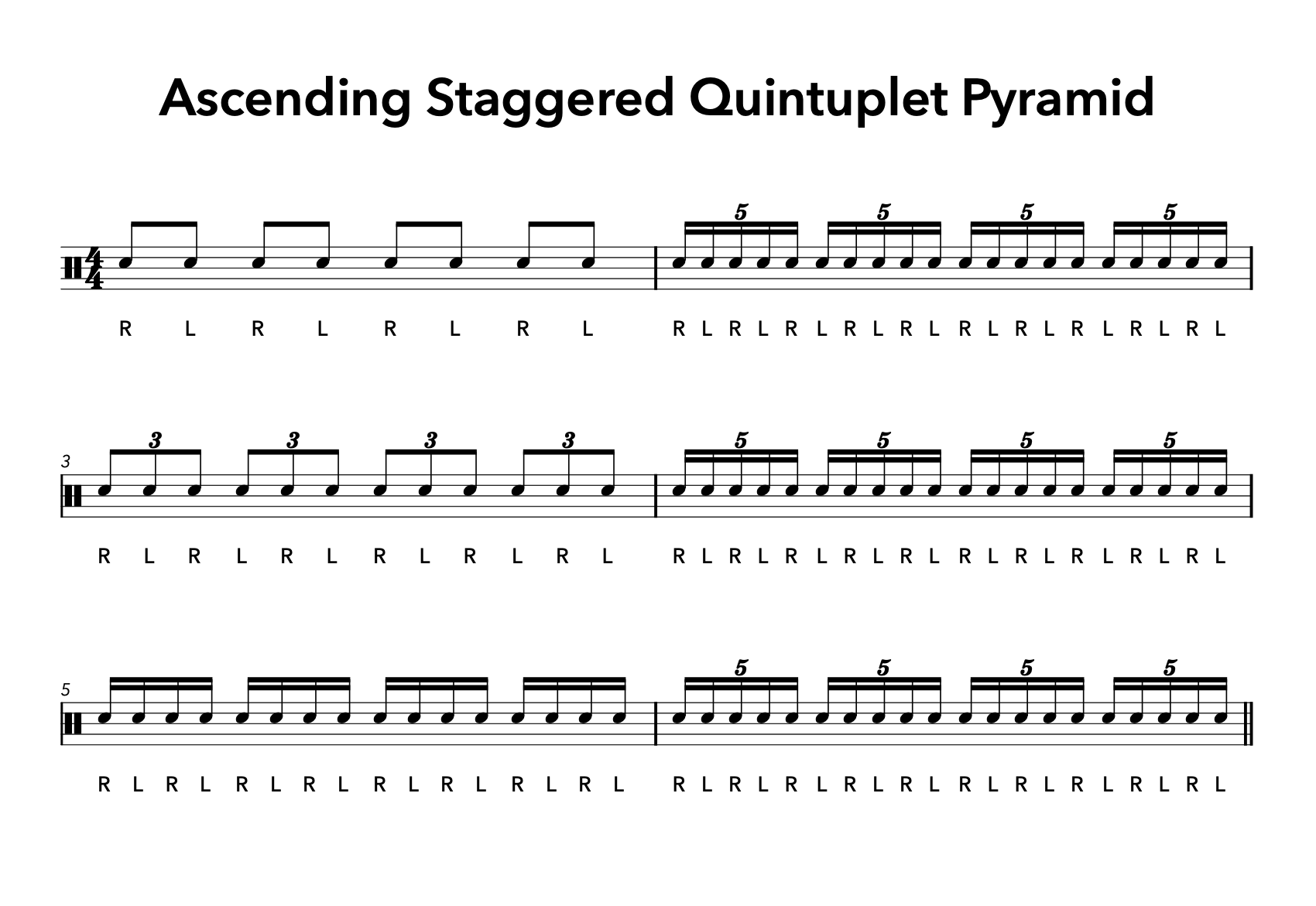TODO: Create blog post image/thumbnail
Quintuplets have become more popular in recent years, showing up in gospel chops, modern fusion, progressive rock, and even hip-hop. But unlike straight subdivisions like 8th notes and 16th notes, which are common in most popular music, quintuplets are a different beast.
While triplets also subdivide the beat in an uneven way, they are more familiar to most drummers. You will hear them in blues shuffles, jazz swing, and compound time signatures like 6/8 or 12/8. But five evenly spaced notes per beat? That is not something most of us internalized early on.
That is exactly why we are kicking off this Beat Note Discover series: to help you build a strong internal feel for quintuplets, starting with the most important aspect — building rock-solid accuracy.
❌ What Not to Do When Starting with Quintuplets
Before we get into the exercises, let me save you some frustration by sharing a few things you should avoid at the start:
- Fancy fills or voicings around the kit — You will just reinforce bad habits. Start simple.
- Playing too slow or too fast — Slow tempos can make the pulse harder to feel. Fast tempos can lead to sloppy execution. Aim for a moderate tempo where you can clearly feel and control each note.
- Jumping into groupings like 3+2 or 2+3 — These are musical and fun, but they mask the even spacing you need to internalize first.
- Switching subdivisions too soon — Practice quintuplets in isolation before mixing them with other subdivisions. Let your body and ears settle into the new rhythm.
✅ What You Should Focus On
- Accuracy — Your first goal is even spacing, not speed or complexity.
- Feel — You want quintuplets to feel as natural to your body as 8ths, triplets, or 16ths.
- Repetition — Repeating a single measure loop is powerful. Do not underestimate it.
How to Practice
Leverage the following features from Drum Notation by Beat Note to enhance your practice:
- Loop each exercise or beat to create focus and get into the zone
- Set the timer to a time you can commit to for each exercise (2, 5, 10, 15 minutes, etc.)
- Don’t jump into the next exercise until you feel comfortable with the current one, and likewise, don’t stay stuck on one exercise for too long if you’re feeling comfortable
- Gradually increase tempo over time, but only if you maintain accuracy
Wouldn’t it be great if we could increase the tempo of our metronome as we get more comfortable with a exercise?
Well, we have an enhancement request just for that! Head over to our product roadmap to case your vote and share your comments. Your input helps us prioritize features that matter most to you.
Foundational Exercises
Begin by building comfort with the new subdivision in isolation. Repetition and simplicity are key here. We’ll save speed and complexity for later.
Four exercises to build a foundational feel for quintuplets, starting with isolated quintuplets and moving to downbeat accents, unaccented to accented beats, and accented to unaccented beats.
Foundational Exercise 1: Isolated Quintuplets (Two-Handed)
Play one measure of quintuplets, alternating hands, starting with your lead hand.
Play it again.
And again.
Over, and over, and over again.
How to Practice:
- Set the Beat Note timer to at least 10 minutes (or longer)
- Start at a moderate tempo, around 60–70 BPM
- Set the Beat Note click to quarter notes to clearly mark the downbeat
- Focus on even spacing and consistent stick heights
You can experiment with various stick heights, as long as your left and right hands are consistent.
Start at a lower dynamic (3” / 7.5cm or 6” / 15cm stick height). Once you feel comfortable with the subdivision, you can start to incorporate higher stick heights (9” / 22.5cm, 12” / 30cm, and so on) to explore dynamic control.
Foundational Exercise 2: Downbeat Accents (Two-Handed)
Play a full measure of quintuplets as in Exercise 1, and this time add accents on the downbeats only (beats 1, 2, 3, and 4).
How to Practice:
- Focus on the downbeats to anchor the feel of the pulse while subdividing in 5s
- Use full strokes for the accented notes and ghost strokes for the rest
- Maintain even note spacing despite the dynamic contrast
Accented notes should be a visibly higher stick height than the unaccented ones. This begins to introduce musical expression while reinforcing subdivision control.
Foundational Exercise 3: Unaccented to Accented Beats (Two-Handed)
Still playing one measure of quintuplets:
- Beats 1 and 3: Play unaccented
- Beats 2 and 4: Play accented
This introduces variation across the measure and helps you build comfort with dynamic shifts between beats.
What’s most difficult about this is the switching of hands due to the odd grouping. Most people have a tendency to still accidentally play the first unaccented note on your non-dominant hand as accented, or louder than the other unaccented notes. This is a common sticking point, so be mindful of stick heights and the energy you put into each stroke.
Foundational Exercise 4: Accented to Unaccented Beats (Two-Handed)
Now flip the previous exercise:
- Beats 1 and 3: Play accented
- Beats 2 and 4: Play unaccented
This gives us the opportunity to practice the opposite direction to improve our control. Like the last exercise, be mindful of the first unaccented note, this time on your dominant hand, and make sure it is just as soft as the other unaccented notes.
Subdivision Switching (Two-Handed)
Once you have built a strong internal sense of quintuplets on their own, the next step is to start switching between quintuplets and other familiar subdivisions. This helps strengthen your timing, sharpen your awareness of rhythmic density, and smooth out transitions between feels.
We will start with 16th notes, then move to triplets, and finally 8th notes. Each increases in difficulty as the space between notes, and thus the contrast between subdivisions, becomes more dramatic.
Subdivision Switching: 16th Notes ↔ Quintuplets
Why 16ths first?
We already built a strong sense of the downbeat in the foundational exercises. While 8th notes might seem simpler, they introduce a lot of space between strokes, which can make switching to a dense subdivision like quintuplets feel jarring.
Starting with 16ths - a tighter, more familiar subdivision - creates a smoother transition. It is like going from 8ths to triplets: just one extra note per beat.
How to Practice:
- Start with a moderate tempo (e.g. 60–70 BPM)
- Use the Beat Note timer to loop for at least 5–10 minutes
- Set the Beat Note click to quarter notes
- Stick with alternating hands — lead with your dominant hand
Progressions:
- One full measure of 16th notes, then one full measure of quintuplets
- Two beats of 16th notes, then two beats of quintuplets
- One beat of 16th notes, then one beat of quintuplets
The final variation is especially tricky — not only do you switch subdivisions every beat, but you also switch which hand leads each beat. This makes sticking and hand control critical. Stickings are included in the Beat Note notation.
Subdivision Switching: Triplets ↔ Quintuplets
Triplets are another uneven subdivision, but they are far more common than quintuplets. This makes them a useful stepping stone for building rhythmic contrast and control.
Progressions:
- One full measure of triplets, then one full measure of quintuplets
- Two beats of triplets, then two beats of quintuplets
- One beat of triplets, then one beat of quintuplets
This variation trains your ear to distinguish between odd-feel triplets and odd-feel quintuplets, both of which sit outside the even grid of straight time. Also, the sticking pattern of triplets, where odd beats (1, 3) always falls with your lead hand and even beats (2, 4) with your non-lead hand, matches that of quintuplets, giving you a similar anchor when playing both subdivisions back-to-back.
Subdivision Switching: 8th Notes ↔ Quintuplets
This is the most challenging of the three - and the most revealing.
Where quintuplets feel tight and compact inside a beat, 8th notes can feel very spacious. Switching between the two highlights the importance of internal time and mental flexibility.
Progressions:
- One full measure of 8th notes, then one full measure of quintuplets
- Two beats of 8ths, then two beats of quintuplets
- One beat of 8ths, then one beat of quintuplets
Pay close attention to the transition moments. The tendency is to speed up the 8ths or drag the quintuplets. Keep your downbeats locked in.
Subdivision Pyramid Variations
TODO: Write brief description
Subdivision Pyramid: Descending Staggered
TODO: Write brief overview
Subdivision Pyramid: Ascending Staggered
TODO: Write brief overview
Subdivision Pyramid: Complete Staggered
TODO: Write brief overview
Complete Pyramid
This pyramid is a great way to practice all the previous exercises in one go. It combines all of the subdivisoins we’ve covered thus far, starting with 8th notes, then triplets, then 16th notes, and finally quintuplets. First we’ll run through a full measure of each subdivision moving our way up and then we’ll reverse our way back to the start.
Then we’ll play two beats of each subdivision, making it a bit more challenging, and lastly, a single beat of each subdivision. Watch the sticking on this last part!
What Comes Next?
This is just the beginning. Once you have locked in the subdivision, we will introduce the next steps: stickings, partials, groupings, voicing, grooves, fills and more - all based on quintuplets.
But for now, your job is simple: just make five notes per beat feel good.
Simple, yes.
But definitely not easy. 😅
Open this pack in Beat Note now → Discover → “Getting Started with Quintuplets”.
Let’s build that internal clock!
_If you found this helpful, share it with your drum fam or tag us in your quintuplet practice clips!
